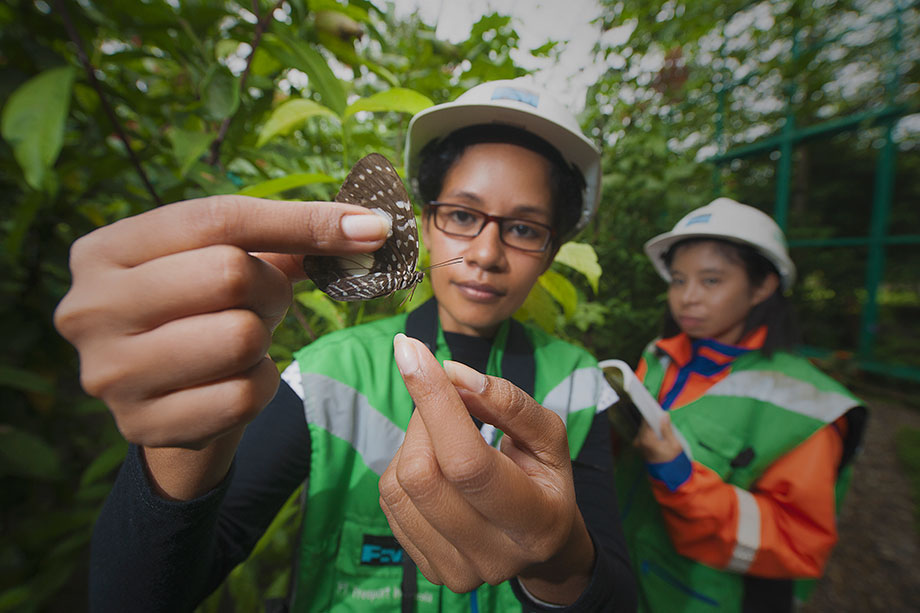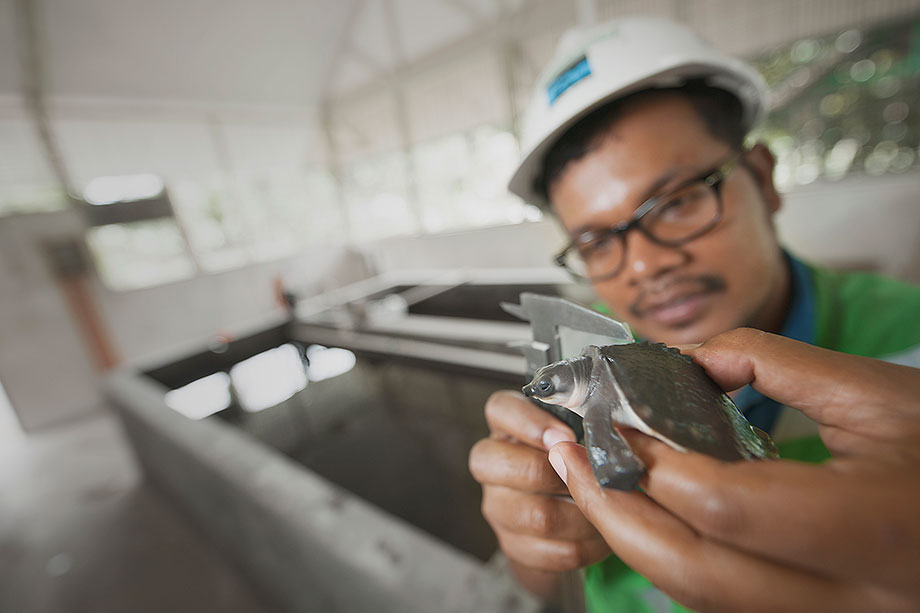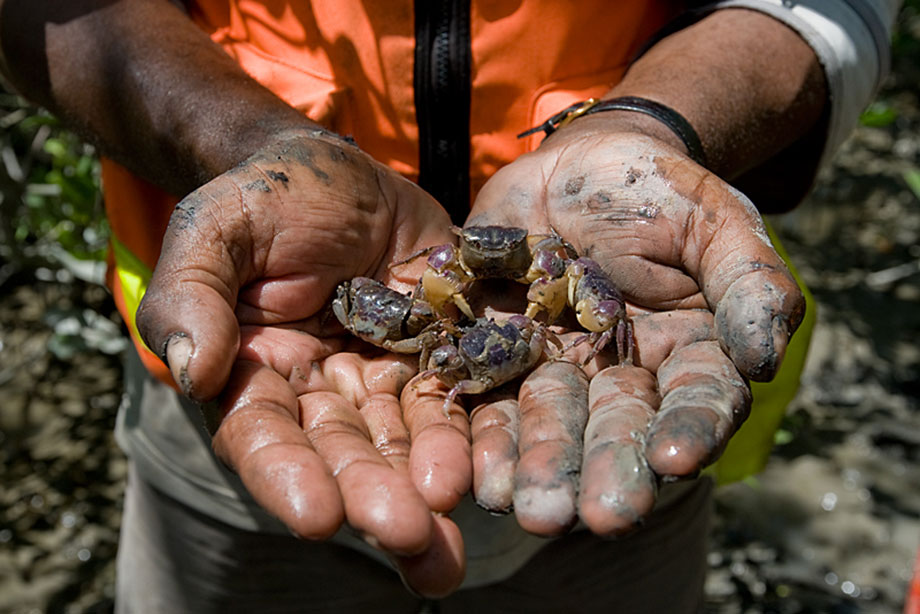The PT Freeport Indonesia is approximately 90 % comprised of different natural ecosystems ranging from mangrove forest to sago palm wetlands, lowland rainforest, heath forest, and montane forest, alpine and subalpine. Since 1994, PTFI has invited national and international scientists to conduct biodiversity studies in the PTFI operating area. Various research activities have been carried out, including on vegetation, mammals, birds, amphibia, freshwater fish, aquatic insects, and terrestrial insects. These research have made the discovery of numerous new species ranging from aquatic biota to terrestrial plants and fauna, such as 16 new crab species, 17 mammal species with unconfirmed identities, and 20-30 potentially new frog species.
 Papilio Ulysses Autolycus is the most beautiful butterfly in Papua that lives in the Freeport Indonesia reclamation center
Papilio Ulysses Autolycus is the most beautiful butterfly in Papua that lives in the Freeport Indonesia reclamation center
Research results are also applicable in the Lorentz National Park area that has been designated a world heritage by UNESCO, as the PTFI operating area directly borders on the Lorentz National Park. With Lorentz National Park’s area of around 2.4 million hectares and its status as the biggest national park in Southeast Asia, information from the results of reports conducted in the PTFI operating area provide an option to references for the management of Lorentz National Park.
 Since 2006 until now, PTFI has released nearly 25,000 pig snout turtles (Carretochelys Insculpta) to their habitat in Papua
Since 2006 until now, PTFI has released nearly 25,000 pig snout turtles (Carretochelys Insculpta) to their habitat in Papua
These various researches have also produced posters, articles and books about Papuan biodiversity, in particular in the Mimika Regency area. Published books include : Fresh water fishes of the Timika Region New Guinea (2000), Aquatic Biota of Mimika waters, Papua (2002), Mimika Butterflies (2003), Birds of Mimika (2004), Subalpine and Alpine fauna of Mimika, Papua Indonesia (2005), Mangrove Estuary crabs of the Mimika Region, Papua (2009), Freshwater crustaceans of the Mimika Region, Papua (2009), Mangrove Estuary Shrimps of the Mimika Region, Papua – Indonesia (2015), Field guide to Frogs of the Mimika Region, Papua-Indonesia (2015) and A guide to the Birds of the Mimika Region-Papua, Indonesia (2015).
 Mud crabs (Sarmatium Germaini) live in the estuary of the tailings deposition area
Mud crabs (Sarmatium Germaini) live in the estuary of the tailings deposition area
In order to support exploration and research in biodiversity in Papua, PTFI has designated permanent plots as monitoring sites in each ecosystem in the PTFI operating area, spanning from the mine area at an altitude of 4,000 meters above sea level, to the coast and sea. Monitoring of diverse vegetation and wildlife is carried out on all sites with the involvement of consultants, research institutions and universities.
In support of maintaining biodiversity in Papua and specifically in Mimika Regency, PTFI has made contributions and collaborated with various entities, including government agencies (the BKSDA Natural Resources Conservation Center, the Quarantine Office, and the local government), NGOs, the local military authority and local communities in Mimika engaged in biodiversity conservation efforts, through activities to return to the wild, Papuan protected and endemic wildlife that had been seized or voluntarily relinquished by members of the public. From the time this collaboration began in 2006, PTFI has helped to release into the wild:
1. More than 41,000 individual pig-nosed turtles (Carettochelys insculpta) in their habitat in various locations in Lorentz National Park;
2. 21 dusky pademelons (Thylogale brunii) in their habitat in Wasur National Park in Merauke, Papua;
3. 139 black capped lories (Lorius lorry) and 7 yellow crested cockatoos (Cacatua galerita);
4. 11 green tree pythons (Morelia viridis), 20 white lipped pythons (Leiophyton albertisi), 1 Papua viper boa (Candoia aspera) and 1 scrub python (Morelia amesthistina);
5. 2 coppery brushtail possum and 1 spotted cuscus;
6. 2 double wattled cassowaries (Casuarius casuari);
7. 3 Papuan freshwater crocodiles (Crocodylus novaguineae) and 2 blue-tongued skinks (Tiliqua gigas).
Various facilities in support of biodiversity conservation have been built, including an ecosystem diorama, a botanical park, a butterfly breeding facility, a transit aviary, and a herbarium laboratory. In addition to the goal of conservation, the facilities are aimed at educating the Mimika Regency public and in particular schoolchildren from kindergarten age onward and university students in Timika.
Various awards and marks of appreciation have been conferred on PTFI for its efforts and commitment to support biodiversity conservation, among others:
1. In 2011, the Wildlife Habitat Council (WHC) in America certified PTFI’s biodiversity program;
2. In 2012, WHC named PTFI’s Environmental Education Program Rookie of the Year for the category corporations for environmental education;
3. In 2014, WHC certified PTFI’s Environmental Education Program as a corporate area for education environmental education;
4. In 2013, 2014 and 2015 consecutively PTFI was conferred an Indonesia Green Award by La-Tofi School of CSR for the biodiversity conservation program category;
In 2017 the PTFI program was honored with the title of GOLD PROGRAM OF THE YEAR by WHC and named an exemplary program out of the 81 other gold program
Kami menghimbau para pencari kerja untuk berhati-hati dan mewaspadai beragam modus penipuan perekrutan yang mengatasnamakan PT Freeport Indonesia. Dalam setiap proses rekrutmen dan penerimaan karyawan, PT Freeport Indonesia maupun konsultan rekruitmennya tidak memungut biaya apapun.
Untuk melihat lowongan, silakan akses melalui link berikut: ptfi e-recruitment
Untuk melihat informasi magang, silakan akses melalui link berikut: Internship Program
